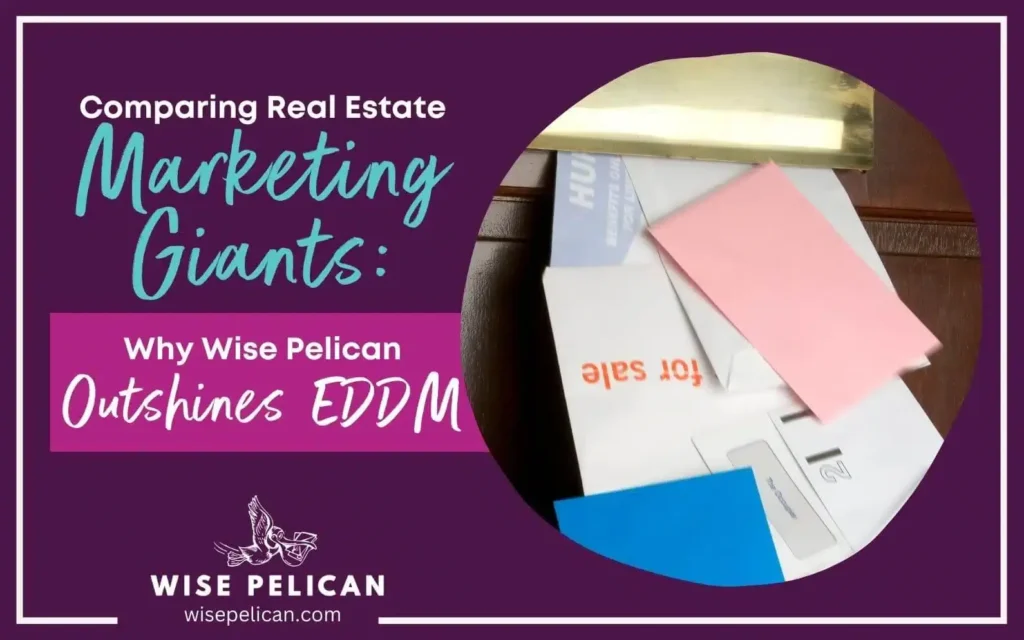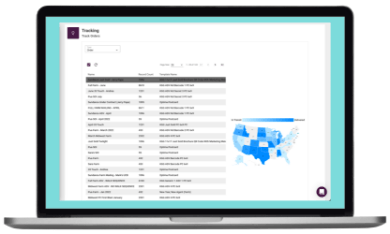If you would prefer to watch a video on USPS EDDM versus Wise Pelican, we have included our YouTube.
Wise Pelican YouTube
In real estate marketing, the appeal of mass mailings, such as Every Door Direct Mail (EDDM), is undeniable.
The idea of reaching a broad audience through a blanket approach seems promising. However, when it comes to the specifics of real estate farming, this approach reveals its flaws.
Mailing to residents means targeting the individuals living in the homes rather than the actual homeowners. This poses a significant problem, as absentee owners, a specific subset of homeowners, often hold the key to more lucrative opportunities.
In this article, we will take a look at USPS EDDM versus Wise Pelican.

The Temptation of Mass Appeal
The foundation of EDDM’s appeal rests on its simplicity—a mass mailing approach that ensures your message reaches every door within a selected geographic area.
This broad net approach seems tailor-made for real estate marketing, where the objective is to cast your net far and wide, hoping to catch potential clients among the masses.
The idea of connecting with all residents within a community has its merits; after all, real estate professionals aspire to be the go-to experts in their neighborhoods.
Real Estate Farming Specifics: Comparing USPS EDDM Versus Wise Pelican
However, when the concept of EDDM meets the specific nuances of real estate farming, the limitations become glaringly apparent.
The crux of the issue lies in the fact that EDDM targets a property’s occupants—those currently residing within the walls of a home.
While this might seem reasonable on the surface, the distinction between occupants and homeowners is where the downfall of EDDM in the context of real estate marketing becomes apparent.
The Homeowner vs. Occupant Dilemma
Real estate isn’t just about properties; it’s about homeowners—the individuals who hold the power to make decisions about selling, buying, and investing.
Mailing to occupants may appear to increase the reach of your message, but it often misses the mark by not reaching the actual decision-makers—the homeowners themselves. This poses a significant challenge, as homeowners are the ones who possess the authority to initiate property transactions.
The Rise of Absentee Owners: A Game-Changing Subset
As the realization dawns that reaching homeowners, rather than occupants, is crucial, a game-changing subset of homeowners emerges—absentee owners.
These homeowners, who own properties but don’t reside in them, are often investors, landlords, or individuals who’ve moved on to new locations.
The significance of absentee owners in the real estate landscape cannot be overstated.
Turnover Rate and Absentee Owners: A Powerful Connection
The appeal of absentee owners stems from their higher turnover rates. These property owners are more likely to sell properties due to their distinct circumstances.
Property investors frequently assess their portfolios for optimal returns, leading them to sell properties when market conditions align.
Individuals who’ve moved out of state might opt to sell their properties rather than maintain remote management. These factors contribute to absentee owners consistently being more open to property transactions.
Unlocking Opportunities with Absentee Owners
Absence does make the heart grow fonder, especially in the realm of real estate marketing.
Absentee owners are not only more likely to engage in transactions, but they also present unique opportunities. Consider the scenario of an absentee owner living out of state.
This homeowner lacks the immediate presence of a local friend, family member, or real estate professional who can provide advice. In this vacuum, the consistent presence of a local real estate agent in their mailbox becomes more than just an outreach effort—it transforms into a beacon of expertise and reliability.
Refining the Strategy: Precision Over Mass Appeal
The real estate market thrives on precision rather than mass appeal. While EDDM might have its place in other marketing scenarios, its broad strokes approach often falls short in the real estate context.
The key is ensuring that your marketing efforts resonate with the individuals with the decision-making power—the homeowners. This focus on precision is where targeting absentee owners comes into play.
Shifting the Paradigm: Embracing Absentee Owner Targeting
As the realities of absentee owner targeting become evident, the paradigm of real estate marketing shifts.
Instead of blanketing a neighborhood with generic messages, the focus shifts to crafting messages that resonate with absentee owners’ unique concerns and needs.
This approach transforms marketing from a mere transactional effort into a personalized connection-building endeavor.
The Way Forward: Tailored Messaging and Tools
Investing in tools and strategies that align with this approach is crucial to harness the potential of absentee owner targeting.
Acquiring high-quality mailing lists that specifically include absentee owners becomes paramount.
Ensuring that these mailing lists are scrubbed through databases like the National Change of Address (NCOA) database guarantees that your messages reach the intended recipients, even if they’ve moved out of state or are leasing their property.

The Goldmine of Absentee Owners: A Closer Look
The concept is simple: absentee owners are more likely to sell properties due to their nature as investors or individuals who’ve moved on.
This higher turnover rate directly translates to increased potential for real estate professionals seeking listings and investment opportunities.
By targeting absentee owners, you’re effectively tapping into a pool of prospects who are more inclined to engage in property transactions, thereby increasing the chances of success in your real estate endeavors.
The Strategic Power of Absentee Owners: Navigating a Landscape of Opportunity
In the complex world of real estate, where each transaction carries the potential for significant gains or losses, one specific segment of homeowners commands attention and respect: absentee owners.
These individuals, who own properties but don’t personally reside in them, are a force to be reckoned with in the world of property transactions. Comprising property investors, landlords, and homeowners with second properties or who have relocated, absentee owners form a distinct subset that should never be underestimated.
Their absence from their properties isn’t just a physical separation; it’s a doorway to unparalleled opportunities that can redefine your real estate career.
Diverse Profiles: A Dynamic Blend of Homeownership
At the heart of understanding absentee owners lies an appreciation for their diverse profiles.
These homeowners span a spectrum, embodying various roles within the real estate landscape.
Motivated by financial growth, property investors actively seek to diversify their portfolios beyond their primary residences. Landlords, driven by the pursuit of rental income, manage properties they may not inhabit themselves.
Meanwhile, homeowners who’ve relocated due to job changes or personal decisions often retain ownership of their previous homes, capitalizing on potential gains or preserving ties to familiar neighborhoods.
Exploring the Motivations for Absence
The reasons behind absentee ownership are as diverse as the individuals themselves. Investment purposes often lead homeowners to acquire properties beyond their local reach, aiming to capitalize on the potential for lucrative returns.
Job relocations or personal choices can prompt homeowners to relocate while retaining ownership of their properties.
For some, maintaining a second property serves as a gateway to future retirement plans or a means of staying connected to beloved neighborhoods.
The motivations driving absentee ownership are nuanced, reflecting the intricate interplay between financial aspirations, life changes, and personal preferences.
The Differential Factor: Absentee Owner Turnover Rate
While absentee owners span a broad spectrum of backgrounds and motivations, what sets them apart is their distinctive higher turnover rate.
This factor is a game-changer, directly influencing the landscape of real estate transactions. The principle is straightforward: absentee owners, be it investors or individuals who’ve moved on, are inherently more inclined to sell their properties.
This higher turnover rate becomes a strategic advantage, offering real estate professionals an avenue to secure listings and investment opportunities that might otherwise remain out of reach.
Navigating the Path of Property Transactions
The connection between absentee owners and higher turnover rates creates a dynamic propelling real estate professionals to succeed.
By targeting absentee owners, you’re navigating a path where each interaction is infused with the potential for meaningful transactions. Property investors, keen on maximizing profits, are primed to sell when market conditions are favorable. Those who’ve moved out of state or who maintain second properties are more open to selling due to their physical detachment from the property.
This strategic targeting taps into a pool of prospects who are inherently more inclined to engage in property transactions.
With each absentee owner you engage with, you’re opening the door to possibilities that hold the potential to reshape your real estate endeavors. The process becomes more than just securing a listing—it’s about building relationships, understanding unique motivations, and navigating a landscape of opportunity.
Investment Opportunities: Beyond Traditional Transactions
The significance of absentee owners doesn’t just stop at traditional property sales. It extends into the realm of investment opportunities.
Absentee landlords, in particular, hold the keys to ongoing partnerships and collaborations. These landlords, who may be interested in selling properties, are also potential candidates for reinvesting or diversifying their portfolios.
Establishing rapport with absentee owners isn’t merely about transactional engagement; it’s about positioning yourself as a trusted resource and forging lasting relationships that pave the way for future endeavors.
Strategies for Success: Harnessing Absentee Owner Potential
To harness the full potential of absentee owners, your strategies must align with their unique profiles and motivations.
Crafting targeted messages that speak to their specific concerns and aspirations creates a resonance that sets you apart from the competition.
Quality mailing lists that focus on absentee owners ensure your efforts are precise and impactful. Scrubbing these lists through databases like the National Change of Address (NCOA) database ensures your materials reach the intended recipients, even if they’ve moved or are leasing their property.
The Power of Expertise: Winning over Out-of-State Absentee Owners
The advantages of targeting absentee owners extend beyond the basic turnover rate statistics.
When it comes to out-of-state absentee owners, the game takes a different turn. These homeowners lack the immediate presence of local acquaintances who could provide real estate guidance. As a result, the opportunities for real estate professionals to stand out and make an impression increase exponentially.
Imagine a scenario where an out-of-state absentee owner is looking to sell their property. They lack a network of friends or family who are real estate experts. In this scenario, consistently receiving messaging from a local real estate agent, who presents themselves as an expert in the neighborhood, holds incredible appeal. The agent’s consistent presence in their mailbox becomes more than just a marketing tactic—it transforms into an assurance of competence and familiarity.
Advantages of Targeting Absentee Owners: Going Beyond Turnover Statistics
When real estate professionals strategize about reaching their target audience, absentee homeowners often emerge as a compelling demographic.
These property owners, who may not reside at their real estate holdings, present distinct advantages extending beyond conventional turnover rate statistics. However, the dynamics shift significantly when focusing on out-of-state absentee owners. In this context, the playing field transforms, offering unique opportunities for real estate professionals to create a lasting impression and stand out from the competition.
A Different Game: Out-of-State Absentee Owners and the Lack of Local Acquaintances
The distinction between absentee homeowners who live relatively close to their properties and those who reside out of state is crucial.
Absentee out-of-state owners face a particular challenge: the absence of immediate local acquaintances who can provide valuable real estate guidance.
While local absentee homeowners might have friends, family, or even colleagues with insights into the local market, those residing in a different state lack this advantage.
This disparity underscores the need for a tailored approach when engaging with such homeowners.
Creating Opportunities for Distinction: The Exponential Impression
The unique circumstances of out-of-state absentee owners make fertile ground for real estate professionals to excel in their roles.
The challenge of navigating a market from a distance creates an opportunity for real estate experts to step in as indispensable guides.
The absence of local contacts who can offer insights means that real estate professionals can position themselves as the primary source of market knowledge, advice, and expertise.
Scenario: Absentee Owner’s Dilemma in Selling Property
To illustrate the impact of this approach, consider the following scenario: an out-of-state absentee owner decides to sell their property. Unlike homeowners with local connections, these individuals lack a network of friends or family members who are well-versed in real estate matters.
Consequently, they’re faced with the daunting task of making critical decisions about pricing and marketing and navigating the intricacies of the selling process on their own.
Leveraging Consistent Messaging: The Role of the Local Real Estate Agent
This is where a proactive and knowledgeable local real estate agent comes into play.
Through a strategic and consistent messaging approach, the agent positions themselves as an expert in the specific neighborhood where the property is located.
By leveraging various communication channels—such as direct mail, email campaigns, and online content—the agent provides the absentee owner with a steady stream of valuable information.
More than Marketing: Transforming Presence into Assurance
The messages from the real estate agent, which arrive consistently in the owner’s mailbox, go beyond being mere marketing tactics.
They transform into an essential assurance of competence and familiarity. Each message reinforces the agent’s dedication to staying connected and providing relevant insights.
As a result, the absentee owner begins associating the agent’s consistent presence with reliable expertise, bridging the gap caused by their physical absence from the property.
The Blueprint for Success: Crafting a Targeted Mailing List Strategy
So, what’s the blueprint for success in crafting a targeted mailing list strategy?
The answer lies in a meticulous approach to selecting your mailing list and ensuring its quality. While every neighborhood and market can vary, certain guiding principles remain consistent.
First and foremost, the emphasis should always be on absentee owners. These homeowners are your prime targets due to their higher likelihood of engaging in property transactions. Look for mailing lists rich in absentee owner data, allowing you to tailor your marketing efforts to this specific audience.
Prioritizing Absentee Owners: The Foundation of Your Strategy
One principle in the elaborate real estate marketing landscape stands tall: prioritizing absentee owners.
These property holders, individuals who possess real estate assets but do not reside on the premises, emerge as the cornerstone of your targeted mailing approach.
The rationale behind this emphasis is rooted in their heightened probability of participating in property transactions. Be it selling, leasing, or purchasing, absentee owners are more likely to be actively engaged in real estate dealings, rendering them an ideal audience to direct your efforts towards.
Rich Data: The Key to Tailored Marketing
Effective targeting hinges on data, and this principle extends unabatedly to crafting a compelling mailing list strategy.
The quest for quality mailing lists necessitates the pursuit of rich and robust absentee owner data. The wealth of information within these lists empowers you to precisely customize your marketing endeavors to suit this distinct audience’s preferences, needs, and behaviors.
Seeking Abundant Absentee Owner Data: A Strategic Imperative
In pursuing the perfect mailing list, your aim should be to acquire comprehensive absentee owner data.
This includes basic contact information and details that offer insights into their property holdings, ownership tenure, and potential transaction history. The more holistic your data, the more effectively you can tailor your messaging to resonate with absentee property owners’ specific circumstances and objectives.

Tailoring Your Message: The Power of Personalization
Once armed with a comprehensive absentee owner dataset, the real magic begins—the art of message customization.
Tailoring your marketing communication to address absentee owners’ unique concerns and aspirations exponentially amplifies your engagement potential.
Whether highlighting the benefits of entrusting their property to a knowledgeable agent or showcasing your expertise in handling remote transactions, personalized messaging establishes a connection that transcends generic marketing approaches.
The National Change of Address Database: A Must-Have Tool
However, your efforts don’t stop at acquiring a mailing list of absentee owners. Ensuring that your direct mail pieces reach their intended recipients is equally crucial.
This is where the National Change of Address (NCOA) database comes into play. The NCOA database is a repository of individuals who’ve changed their addresses through the postal service.
Running your mailing list through the NCOA database helps to ensure that your mailings reach the correct individuals, especially in cases where homeowners have moved out and are leasing their property to tenants.
This step prevents your marketing efforts from going to waste, ensuring that your materials land in the hands of the homeowners themselves, even if they’ve moved out of state or are leasing their properties.
Navigating the Landscape with the NCOA Database
The NCOA database is a powerful ally in the quest for precise mail delivery.
It serves as a comprehensive repository, housing records of individuals who have undergone address changes through the postal service.
This database captures critical address alteration information, whether due to relocations within the same city or moves across state lines.
Leveraging this resource allows you to adapt your marketing strategy to the ever-evolving addresses of your target audience.
Preserving Relevance with Address Updates
A crucial scenario that underscores the importance of the NCOA database is when homeowners transition from residing in their properties to becoming absentee landlords who lease their properties to tenants.
In such cases, the potential for mailing materials to outdated addresses becomes a genuine concern. This transition can complicate the direct mail process, potentially leading to misdirected marketing materials and disconnection between your efforts and your intended audience.
The NCOA Solution: Preventing Wasted Efforts
Running your acquired mailing list through the NCOA database serves as a preventive measure against the pitfalls of outdated addresses.
This step is pivotal in ensuring that your direct mail materials successfully land in the hands of the intended recipients, regardless of whether they have moved out of state or are leasing their properties.
By making necessary adjustments based on updated address information, you safeguard your marketing investments and maximize the impact of your outreach.
Enhancing Accuracy and Relevance
The NCOA database not only safeguards the efficiency of your marketing endeavors but also enhances the accuracy and relevance of your communications.
As your audience’s circumstances evolve, your messages can evolve in parallel. By being informed of address changes and updates, you position yourself to deliver specific content that resonates with recipients’ current situations and real estate aspirations.
Tracking and Evaluating Returns: The Path to Refinement
As with any marketing strategy, tracking and evaluating the returns on your investment are critical. Implement mechanisms to monitor the responses and engagement generated by your direct mail campaigns.
By analyzing which campaigns yield the most favorable outcomes, you can refine your approach and tailor your future efforts to maximize success.
Mechanisms of Measurement: Capturing Responses and Engagement
The journey towards gauging the effectiveness of your direct mail campaigns commences with implementing mechanisms that capture responses and engagement.
This entails creating clear and compelling calls to action within your direct mail pieces—inviting recipients to take specific steps, such as visiting a website, calling a dedicated number, or participating in an event. These actions serve as valuable touchpoints for measuring your materials’ level of interest and interaction.
Analyzing Campaign Outcomes: Unveiling the Success Factors
Once responses start flowing in, the next critical step is to delve into the analytics and analyze campaign outcomes.
This involves scrutinizing various metrics, such as the number of responses, conversion rates, website visits, and inquiries generated.
By meticulously dissecting these figures, you gain insights into which specific campaigns resonate with your target audience and prompt the desired actions.
Refining Your Approach: Navigating Insights for Future Success
The power of tracking and analysis lies in refining your approach based on the insights garnered.
You have a blueprint for success when you identify the campaigns that yield the most positive outcomes—whether that’s a surge in inquiries, increased website traffic, or conversions.
Armed with this knowledge, you can tweak your messaging, design, and strategy to align more closely with what truly engages and motivates your audience.
Tailoring Future Efforts: Maximizing Impact
The iterative nature of real estate marketing means that each campaign informs the next.
The insights gained from tracking and evaluating your direct mail initiatives empower you to adjust your future efforts precisely.
You can optimize your targeting, personalize your messages, and strategically allocate resources to areas that have been proven to deliver the highest returns on investment.
The Cycle of Improvement: A Continuous Journey
The cycle of tracking, evaluating, refining, and tailoring is a continuous journey that propels your real estate marketing strategy toward constant improvement.
As you consistently analyze the outcomes of your direct mail campaigns, you nurture a culture of adaptation and growth.
This proactive approach positions you to navigate shifts in market dynamics, changing consumer preferences, and evolving trends, ensuring your strategy remains agile and effective.
The Lasting Impact of Strategic Mailing
In a realm as competitive as real estate, every edge matters. Strategic mailing, especially when targeting absentee owners, can give you the competitive advantage needed to thrive.
This approach goes beyond mere correspondence; it establishes your expertise, builds relationships, and secures listings that might have slipped through the cracks.
So, while Every Door Direct Mail might have its place in other contexts, in the realm of real estate, precision matters. By understanding the nuances of absentee ownership and harnessing tools like the NCOA database, you can ensure that your mailing efforts are precise, impactful, and poised for success.
The world of absentee owners is waiting to be unlocked—an untapped goldmine of real estate opportunities that can define your career and revolutionize your approach to the industry. Are you ready to take your real estate marketing game to the next level? Say goodbye to the limitations of Every Door Direct Mail (EDDM) and say hello to a new era of precision and impact with Wise Pelican Direct Mailing!






